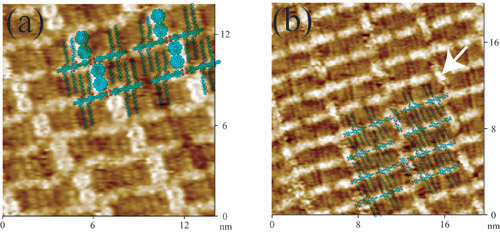Controllable distribution and dispersion of organic/bio- molecules on solid surface are very important issues in nanomaterials and nanotechnology. In particular controllable arrangement of single molecules is the prerequisite for the development of nanodevice. To obtain a well-ordered distribution of nanoparticles or quantum dots various templates such as PS beads were developed. These achievements have contributed to the understanding of intermolecular adsorbate/substrate interactions and the implication in chemistry biology and physics. Until now it still remains a challenge to control the ordering in multicomponent mixtures at molecular level. Most binary mixtures investigated show phase separation on the nanometer scale or the formation of randomly mixed monolayers.
In this paper by using the self-assembled template fabricated via end-functionalized oligo(phenylene-ethynylene) (OPE) organic semiconductor coronene (COR) and biomolecules such as tripeptide are well controlled distributed and monodispersed on highly oriented pyrolytic graphite (HOPG) surface. Within the molecular template COR molecules were controllably distributed into various arrays just by simply adjusting the molecular molar ratio. Tripeptide TGG molecules were uniformly positioned at vacancies of OPE template. Noncovalent hydrogen bonding plays an important role for the controllable distribution and dispersion. The present method from self-assembly provides a facile way to fabricate ultra-small electronic components sensing elements and scaffolds for biomaterial engineering.
J. Am. Chem. Soc. (2006 128 12384-12385)

(a) Two COR molecules are dispersed into each vacancy of OPE template;.
(b) Tripeptide molecules are uniformly dispersed into the vacancy of OPE template.
, |
